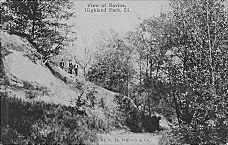| Entries |
| H |
|
Highland Park, IL
|
 Lake County, 23 miles N of the Loop. Highland Park's bluffs, lake vistas,ravines, and accessibility to Chicago support the foresight of nineteenthcentury developers whoenvisioned this picturesque suburb as a retreat for Chicago's affluent professionals.
Lake County, 23 miles N of the Loop. Highland Park's bluffs, lake vistas,ravines, and accessibility to Chicago support the foresight of nineteenthcentury developers whoenvisioned this picturesque suburb as a retreat for Chicago's affluent professionals.
Indian trails and mounds indicate that before the Black Hawk War, Potawatomi traversed the forested acres that became Highland Park. German immigrants founded two village ports, St. Johns (1847), and Port Clinton (1850), in hopes of opening hinterlands for trade.
By 1855, Walter S. Gurnee, former Chicago mayor, North Shore real-estate speculator, and president of the Chicago & Milwaukee Railroad, took control of the Port Clinton Land Company and platted the area for residential settlement. Gurnee surmised that rail offered the best link to Chicago, and that residential development, rather than commercial, would succeed.

|
Residents supported investment in a public library (1887) and annexed the village of Ravinia, south of Highland Park, in 1899. By the turn of the century, Highland Park's population was 2,806, and socially, if not economically diverse. Institutions such as the Gads Hill Summer Settlement House encampment, the Railroad Men's Home, and Wildwood, a resort for German-Jewish families excluded from suburban country clubs, attest to this diversity. Unlike many of its suburban neighbors, Highland Park welcomed a sizable Jewish population after World War II.
The city experienced two growth spurts—in the 1920s, when the population grew by 98 percent to 12,203—and in the 1950s, when it leapt 52 percent to 25,532. Careful planning has protected the area's appeal by promoting its village character and building on its strengths of private and public amenities. The Ravinia Music Festival is one such legacy that began as a recreational park and cultural center established in 1904 by A. C. Frost. Each summer, tens of thousands of visitors enjoy classical and popular concerts in a wooded outdoor setting, including performances by the Chicago Symphony Orchestra.
| Highland Park, IL (inc. 1869) | |||||
| Year |
Total
(and by category) |
Foreign Born | Native with foreign parentage | Males per 100 females | |
| 1900 | 2,806 | 23.3% | 38.5% | 100 | |
| 2,793 | White (99.5%) | ||||
| 12 | Negro (0.4%) | ||||
| 1 | Chinese (0.0%) | ||||
| 1930 | 12,203 | 18.5% | — | 90 | |
| 12,004 | White (98.4%) | ||||
| 177 | Negro (1.5%) | ||||
| 22 | Other (0.2%) | ||||
| 1960 | 25,532 | 26.5% | 34.9% | 91 | |
| 24,979 | White (97.8%) | ||||
| 504 | Negro (2.0%) | ||||
| 49 | Other races (0.2%) | ||||
| 1990 | 30,575 | 10.9% | — | 96 | |
| 28,756 | White (94.1%) | ||||
| 684 | Black (2.2%) | ||||
| 8 | American Indian (0.0%) | ||||
| 775 | Asian/Pacific Islander (2.5%) | ||||
| 352 | Other race (1.2%) | ||||
| 1,274 | Hispanic Origin* (4.2%) | ||||
| 2000 | 31,365 | 15.3% | — | 96 | |
| 28,606 | White alone (91.2%) | ||||
| 559 | Black or African American alone (1.8%) | ||||
| 24 | American Indian and Alaska Native alone (0.1%) | ||||
| 716 | Asian alone (2.3%) | ||||
| 4 | Native Hawaiian and Other Pacific Islander alone (0.0%) | ||||
| 1,086 | Some other race alone (3.5%) | ||||
| 370 | Two or more races (1.2%) | ||||
| 2,792 | Hispanic or Latino* (8.9%) | ||||
The Encyclopedia of Chicago © 2004 The Newberry Library. All Rights Reserved. Portions are copyrighted by other institutions and individuals. Additional information on copyright and permissions.